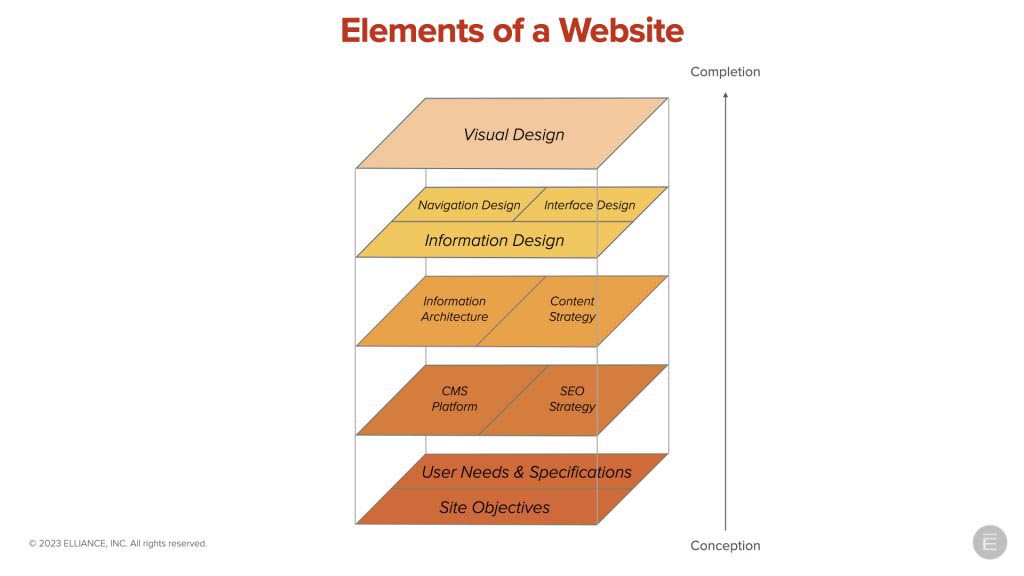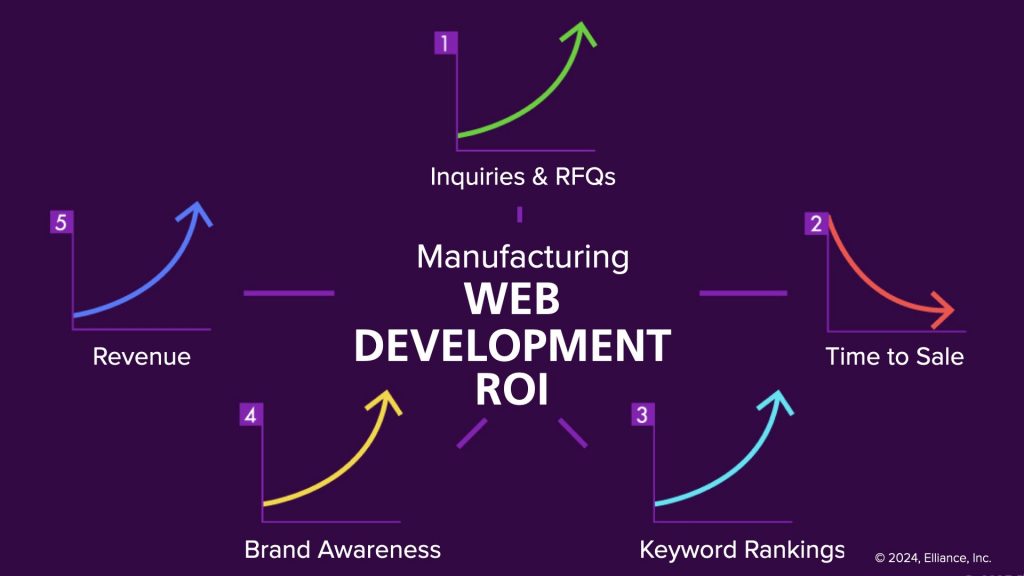| Mar 2, 2024
Manufacturing website development agency shares best practices in industrial website development

Today, more than any other touch point, a website is the digital soul of an organization. As one of Pittsburgh’s longest standing manufacturing website development agencies, Elliance has been delivering prosperity to regional and national industrial companies for the past 30 years. Our arsenal of website development best practices includes:
1. Start With a Smart Strategy and Plan
Revenue Strategy, Communication Strategy and Search Engine Ranking Strategy are the three pillars of a smart manufacturing website development strategy. Bake each of them into every stage of website development.
A good website development project begins with a thoughtful plan. Map out and outline all of these facets up-front:
- Ambitious goals and objectives – for inquiries, revenue, communications and search engine
- Target audiences – buyers, influencers, specifiers and talent of all ages you plan to recruit
- Requirements and needs – for users (stated and unstated), business, content administrators
- Content strategy – in service of delighting each target audience
- Specifications – for user experience and interactive elements
- Functional requirements – including a system of calls-to-action
- Merchandising approach – for selling, cross-selling and up-selling of products and services
- Integration requirements – with analytics, marketing automation and third-party applications
- User experience requirements – including design, progressive disclosure, and navigation system
- SEO strategy – infusing keywords in every phase to ensure Google and Bing page one rankings are secured
- Domain architecture – for the primary website and potential campaign landing pages
- Content-migration and URL redirects – retaining your past SEO rankings and building upon them
Despite all the planning, be prepared for some surprises along the way such as with third-party integrations and new requirements surfacing midstream.
Aim higher to meet the needs of more digital savvy users.
2. Make it Easy to Use for Content People
Content people naturally don’t have sufficient programming know-how. They are looking for easy to use, point-click-and-type interfaces on their website platform. They want the ability to view content as the website user would experience it before publishing. They want the ability to roll-back if the need arises. A sound website platform should support workflows, access control lists (ACL), the ability to create a smart page builder, create-once-publish-everywhere capabilities and development-staging-production environments.
Delight content people.
3. Make it Beautiful
Strategy is invisible. Good design makes it visible.
There is a generational change of guard underway that is affecting manufacturing. Boomers are retiring and Gen-Xers, Millennials and Gen-Zers are taking over. This is true for both industrial buyers and young talent they are trying to recruit. Manufacturers can’t expect these people to buy into or buy from a company with a tired, old manufacturing aesthetic. Younger buyers and talent are increasingly digitally savvy. To appeal to them, manufacturing websites should consider incorporating nature-inspired organic forms, cool digital design, and interactive energy. They need to convey manufacturing expertise backed by thought-leadership and a quiet, confident modernity.
Milton Glaser, the iconic designer, once said “There are only three reactions to a piece of design: no, yes or WOW! Wow is one to aim for.” We couldn’t agree more.
4. Appeal to Strategic Buyers, Tactical Buyers and Influencers.
Smart manufacturing marketers realize that not all customers are born equal. New websites are focused on converting both high-margin strategic buyers and an emerging generation of tactical buyers. Along the way, they must persuade the influencers also.
Increasingly, buying is a committee decision. Meet the needs of all members of this comittee.
5. Build Critical Features
Here are some smart features worth considering offering to your smart engineering-minded buyers:
- Product catalog and services – as a quick reference to your offerings
- Custom solutions – to facilitate higher-margin, complex sales
- Project galleries – to showcase your solutions in action
- Markets served – to reduce buyer’s risk of buying from you
- Customer stories, testimonials and third-party validations – again to reduce their risk of buying from you
- Auto-complete site search – to give quickest path to your products and services to repeat buyers
- Faceted search – to show depth and breadth of product (and service) offerings
- Configurators – to engage your buyers
- Resource center – to provide convenient access to all your brochures and spec sheets
- Blog – to convey product and thought leadership, and fresh content to feed the Google and Bing bots
- Customer portal – to enable customers to find answers to routine questions about their past purchase history, warrantees, add-ons, and a whole lot more
- Multi-language support – to facilitate international and multilingual buyers
6. Make it Search Engine Friendly
If a manufacturer can’t be found on page one of Google or Bing, its products can’t be bought. 90% of users never go beyond page 1 of Google results. Organic rankings (i.e. the top 10 natural search results) are clicked more, trusted more, and convert three-folds better than paid ads.
Manufacturing website designers and developers must start their projects in collaboration with SEO marketers who’ll research and assemble crucial search phrases in a Keyword Lexicon. The lexicon should inform all aspects of website design including user experience, information architecture, initial website content, website development and ongoing content upgrades. Keyword categories in the lexicon should include products/services, applications, industries, reputation, decisioning, and strategic buyer questions. Keywords must include a variety of phrases used across the buyer journey and the talent recruitment journey. It is imperative for the website designers to use SEO best practices to ensure that manufacturer’s products and services, thought-leadership content as well as job postings can surface on page one of Google and Bing.
Google page one is destiny.
7. Make it Mobile-First, Responsive, Fast-Loading and ADA-Compliant
These factors are both good for business and good for search engine rankings.
Given that close to half of website traffic now comes from mobile devices, build a responsive website (i.e. auto-adjusts to various browsing devices) that is mobile first and delights people. Since page load speed is a Google ranking factor, avoid cheap hosting services, and ensure the website developers have a proven record of building clean, efficient and fast code. Make your website ADA compliant (WCAG AA 2.2) website to serve all audiences and avoid being sued by unscrupulous law firms chasing non-compliant websites.
What you can’t see can hurt you.
8. Power With Smart CMS Technology wtih a Maintenance Mindset
Google rewards fresh content. The ease of uploading new content and updating the website depends on your chosen content management system (CMS).
Depending on website requirements, the size of your organization, your need for flexibility and internationalization, availability of in-house technology talent and budgets, you must either pick a proprietary, open source or commercial grade CMS that best suits your needs. Ensure it support a “Smart Page Builder” that lets you create your entire website and custom layouts from a single interface. Ensure it is thoroughly SEO-friendly and plays well with other software components such as analytics, marketing automation software, CRM software, tracking tools, and more. Most importantly it should be easy to use for content people.
Since websites are dynamic entities, it should be coded to be simultaneously logical and easily maintainable. Documenting the code is crucial.
A good CMS should let you operate a website with almost the same ease as you use utilities at home.
9. Test, Test, Test and Then Test Some More
Zero defects matter as much for websites as they do in manufacturing.
In accordance with quality guru Dr. Deming’s advice, ensure that quality is built into every phase of the project. However, to ensure that the end-product meets the highest standards of quality, test the pre-launch website across a number of platforms and devices to ensure that the responsive design maintains its integrity, passes the Google mobile friendly test, and adheres to Google Core Web Vitals guidelines. Test on common smartphones, tablets, desktops and laptops, as well as the most recent versions of popular web browsers whose usage is more than five percent of the total website traffic. In addition, test each website page for ADA WCAG 2.2 Level AA compliance using a variety of automated testing tools (WAVE, FAE, AXE, DubBot) as well as manual testing to ensure that these standards are met.
Aim for nothing less than zero defects.
10. Build for Security
Prepare yourself for a world where a cyberattack is initiated every 39 seconds.
Build your website code with protections from spam and SQL-injection. Use HTTPS and stay up to date on SSL/TLS versions. Ensure operating systems and CMS security patches are installed as they surface, a few times a month.
The last thing you want to experience is website downtime or to be held hostage to ransomware.
11. Host It Right
Because websites are mission-critical, people are impatient and Google penalizes slow websites with lower rankings, hosting matters a lot.
- Ensure your website is hosted securely on a high-speed Tier-1 environment, and weekly software and security patches are deployed.
- Protect your website hosting environment from ever-evolving malware and attacks. Apply security patches promptly.
- Keep your uptime high with 24×7 monitoring and daily backups.
- Automate infrastructure configuration and code deployment.
Cheap shared hosting will hurt you.
12. Implement Kaizen Principles of Continuous Improvement
In business as in life, the ground beneath our feet keeps shifting. A great website is a living, breathing information organism that adapts to the changes taking place in the business environment.
Implementing Kaizen principles for a website involves continuous improvement and optimization of various aspects to enhance user experience, increase efficiency, and achieve business goals. Improve user experience with user feedback, fortify persuasion based on what rainmakers are saying is working now, optimize pages based on what performance tools are reporting, tweak SEO meta-data and copy with newest insights, improve conversion paths based on user behaviors, and implement security patches as new vulnerabilities are discovered and announced.
After a website goes live, SEO engagements and paid advertising campaigns become the touch points where ideas are exchanged between us and our clients. These are crucial moments of change and adaptation that deliver long-term success that clients had hoped to achieve.
13. Measure ROI
You can’t manage what you can’t meausre.
Upstream ROI metrics include increase in inquiries and demand, achievement of thought leadership, and increase in brand value. Keep an eye on downstream metrics also such as bounce rates, conversion rates, time on site, growth in organic traffic, content popularity, expansion in reach, and more. Establish regular meetings to measure ROI.
What ultimately matters is not the effort but the return-on-your-website-investment.

Remember, the underpinnings of great websites are simplicity, humanity and performance. The simpler and more predictable the user experience and the more human-friendly the content administrator’s experience, the more complex your website backend will be. Great website developers lean into this paradox and love delivering joy, brilliance and satisfaction to both website users and content administrators. They prefer long-term client relationships so the website continues to evolve and perform better every month and every year.
Looking for a professional manufacturing marketing agency to design and develop your website? Review our website design and website development expertise and contact us if you wish to join the elite group of manufacturers enjoying business growth with their websites.
